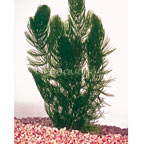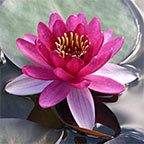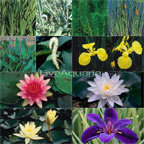Pond Plants do have a job and purpose in the ecosystem of a pond. Although there are well over a hundred types of plants, let’s break it down to a few categories. Oxygenation, provision of shade or ornamentation and food for the fish.
 |
Pond Plants for Oxygenation.
Anacharis, Cabomda, and Hornwort need to be added in discretion as they spread easily and may need thinned out at times. These plants will grow if thrown into the pond floating about, but this looks a little messy, it’s better to tie a small rock and drop into the pond, or place roots under a stone or plant pot. They are a favorite food of the fish. With the small shallow root system the fish could uproot the plant, and then they would be floating around the pond again. To help prevent this, use netting or fence off the plants and let the fish eat what gets threw the netting. Having a small root system, the plant uses the nutrients from the water directly through their leaves. The more nutrients they use, the less will be available for Algae to feed from.
Pond Plants to help limit sunlight and cool the water, are water lilies. Basic two groups are
 |
Hardys and Tropicals with many variations and colors. The main difference, hardys bloom during the day while tropical water lilies can bloom day or night, and the only group that contains blue and purple flowers.Red, white and pink bloom at night. These plants are rooted in the pond in shallow, still water, while the leaf and flower float on the surface. Hardys do best at 8” to 16” below the surface with 4 or more hours of sunlight. Tropicals need at least 6 hours and set 12” to 16”under the surface. These pond plants should be planted in May, and recommended to place in a sand bed. Other options are baskets with heavy soil, or by wrapping sod around the roots( grass side in) with a little charcoal for purity. In time the biodegradable baskets and sod will rot away, if there is soil in the pond the roots will have taken over by then. If the pond has a liner then put the plants into pots. Flowering pond plants should be fed to get the best performance, and blooms from them. Another type of pond plants is for the shallows where the water is three inches deep, and just plain wet called bog plants. They come in both hardy and tropical. One of which is the Lotus. Colors are white, red, yellow, and pink. There are many species from small, one foot tall, to large eight feet tall. Be careful as they will reproduce rapidly but are desired for their water filtering abilities.
 |
Wintering pond plants can be done by potting them and bringing them in doors letting them live in a small pool. The other option is to cut the tops off and lower them about 30 inches deep. It is possible that you could lose a few but the same could happen with digging up and potting. Northern zones should stick with the hardys, tropical will need wintered indoors. Most important is to stick with the native species of plants within your area. Some pond plants are illegal to transport and others can migrate to your neighbors pond by wind or animals. Your neighbor my not want the pond plants you have…
